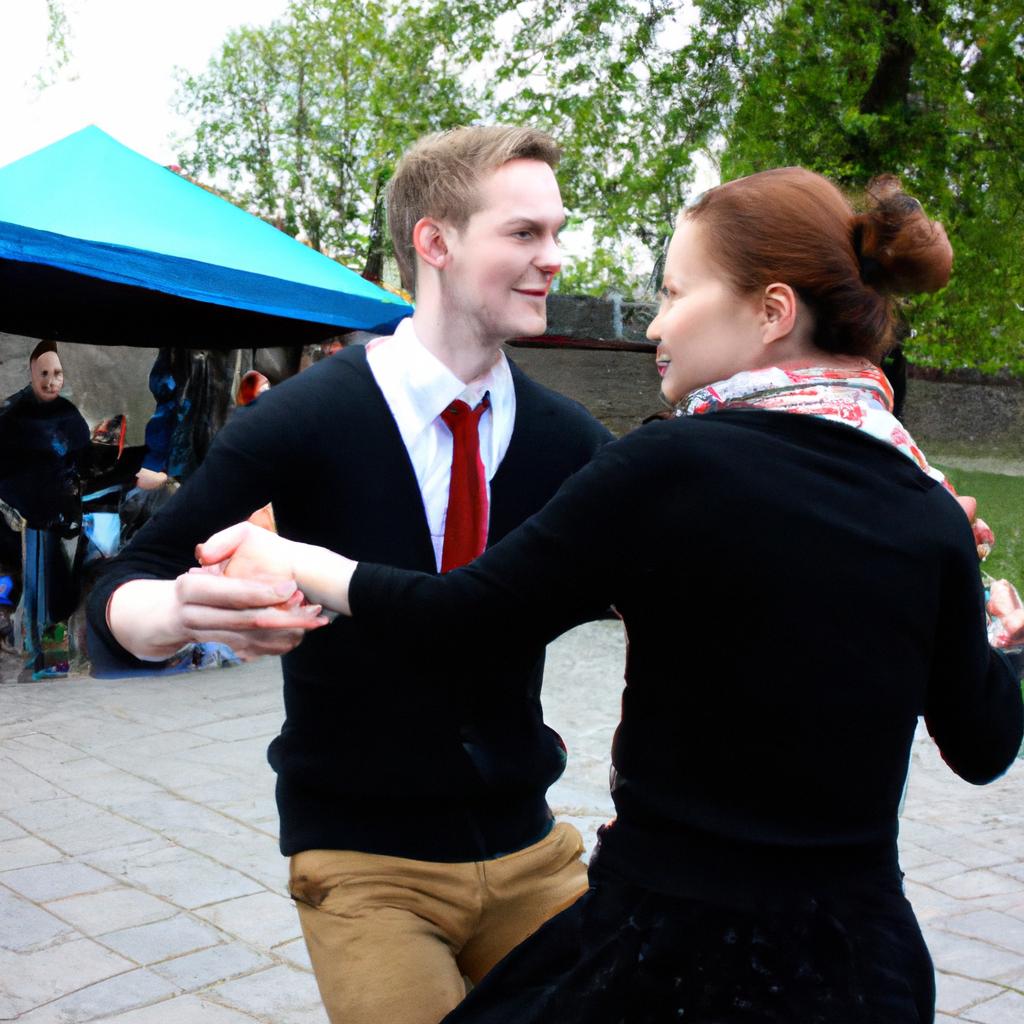Contemporary dance, a form of expressive movement rooted in the exploration of personal and emotional expression, has gained significant popularity in recent years. This article aims to delve into the intricate artistry and physicality that characterizes contemporary dance, as well as its applicability in both recreational activities and competitive sports settings.
Consider the case study of Sarah, a professional athlete who incorporates contemporary dance into her training regimen. As an Olympic gymnast, she discovered that traditional conditioning exercises were not sufficient for fully developing her range of motion and artistic expression on the floor exercise. Seeking a creative outlet to complement her rigorous athletic routine, Sarah turned to contemporary dance. Through this form of movement, she was able to explore fluidity, gracefulness, and individual interpretation – qualities that seamlessly integrated with her gymnastics routines, enhancing her overall performance on the international stage.
In addition to its relevance within competitive sports domains like gymnastics or figure skating, contemporary dance also offers numerous benefits for individuals seeking recreational outlets for self-expression and physical fitness. By engaging participants in a dynamic blend of technique and improvisation, it fosters opportunities for creativity while simultaneously improving flexibility, coordination, strength, and cardiovascular endurance. Moreover, its emphasis on connection between mind and body promotes mindfulness practices which can enhance mental clarity, reduce stress, and improve overall well-being.
Contemporary dance encourages individuals to explore their emotions and personal narratives through movement. It provides a safe space for self-expression, allowing participants to release pent-up emotions or communicate complex feelings that may be difficult to express verbally. This can be particularly beneficial for those who struggle with traditional forms of communication or have experienced trauma, as it offers an alternative means of processing and healing.
Furthermore, the physical demands of contemporary dance contribute to improved physical fitness. The combination of strength-building exercises, dynamic movements, and cardiovascular endurance training results in increased stamina, muscle tone, and flexibility. Regular participation in contemporary dance classes can also lead to improved posture, body awareness, and coordination.
The inclusive nature of contemporary dance makes it accessible to individuals of all ages and abilities. While professional dancers may spend years refining their technique and performing intricate choreography, beginners can still reap the benefits of this art form by starting with basic movements and gradually progressing at their own pace. Whether participating in a structured class or engaging in freestyle improvisation at home, individuals can embrace the joy of movement and find fulfillment in expressing themselves through contemporary dance.
In conclusion, contemporary dance is an expressive art form that offers numerous benefits for both competitive athletes like Sarah and individuals seeking recreational outlets for self-expression and physical fitness. Its emphasis on creativity, emotional exploration, and mind-body connection make it a valuable tool for personal growth and overall well-being. So whether you’re looking to enhance your athletic performance or simply unleash your inner artist, consider incorporating contemporary dance into your life – you might just discover a whole new world of possibilities!
The History of Contemporary Dance
Contemporary dance, a dynamic and expressive form of movement that emerged in the early 20th century, has evolved to become an integral part of modern-day recreation and sports. To better understand its significance in these contexts, it is essential to delve into the history and evolution of contemporary dance.
One example that highlights the transformative power of contemporary dance is the case study of Martha Graham. As one of the pioneers of this art form, Graham challenged traditional ballet techniques by emphasizing grounded movements and expressing raw emotions through her choreography. Her iconic piece “Lamentation,” performed in 1930, captivated audiences with its evocative portrayal of grief and despair. This breakthrough performance marked a turning point for contemporary dance, as it showcased how movement could be used as a means of storytelling and emotional expression.
To fully grasp the impact of contemporary dance on individuals’ lives, consider the following bullet points:
- Emotionally empowering: By exploring various themes such as love, loss, joy, or anger through movement, contemporary dance provides a cathartic outlet for self-expression.
- Physical well-being: Engaging in this form of artistic physical activity improves flexibility, strength, endurance, coordination, and overall fitness levels.
- Mental stimulation: The creative process involved in learning and performing contemporary dance routines stimulates cognitive abilities such as memory retention and problem-solving skills.
- Social connection: Participating in group classes or performances fosters a sense of community among dancers who share their passion for this unique art form.
Moreover, examining the historical timeline reveals key moments that shaped contemporary dance into what it is today. From Isadora Duncan’s free-flowing movements inspired by nature to Merce Cunningham’s emphasis on chance operations and collaboration with avant-garde composers like John Cage; each era brought forth new ideas and expanded boundaries within this ever-evolving discipline.
In conclusion with regards to understanding the influence of contemporary dance in recreation & sports, it is essential to recognize its rich history and the emotional impact it has on individuals. This sets the stage for exploring how contemporary dance not only enhances recreational activities but also influences various sports disciplines. Transitioning into the subsequent section about “The Influence of Contemporary Dance in Recreation & Sports,” we will delve deeper into this fascinating realm where artistic expression meets physical performance.
The Influence of Contemporary Dance in Recreation & Sports
Transitioning from the rich history of contemporary dance, we now delve into its profound influence on recreation and sports. To illustrate this impact, let us consider the hypothetical case of a recreational center that incorporated contemporary dance as part of their fitness program. This integration not only provided participants with a unique avenue for creative expression but also offered numerous benefits to both physical and mental well-being.
The incorporation of contemporary dance in recreation & sports has led to various positive outcomes. Firstly, it encourages individuals to explore new ways of moving their bodies, fostering personal growth and self-discovery. Participants learn to embrace diverse styles and techniques within contemporary dance, allowing them to break free from conventional movement patterns. This freedom ultimately expands their range of motion, leading to enhanced flexibility, strength, and coordination.
Furthermore, participating in contemporary dance provides an opportunity for social interaction and community building. People come together in classes or workshops, forming connections through shared experiences and collective creativity. This sense of camaraderie not only enhances motivation but also creates a supportive environment where individuals can encourage each other’s progress.
Through incorporating contemporary dance into recreation & sports activities, several emotional benefits emerge:
- Increased self-confidence: As individuals master intricate movements and express themselves through dance, they develop a stronger belief in their abilities.
- Stress relief: Engaging in rhythmic movements accompanied by uplifting music offers a therapeutic escape from daily stressors.
- Improved body image: By focusing on fluidity rather than rigid aesthetics, contemporary dance promotes acceptance and appreciation for all body types.
- Enhanced emotional expression: Dance serves as an outlet for emotions that may be difficult to articulate verbally.
To further understand the impact of integrating contemporary dance into recreation & sports programs, let us examine the following table showcasing four key areas influenced by this inclusion:
| Area | Impact |
|---|---|
| Physical Fitness | Improved flexibility |
| Increased muscular strength | |
| Enhanced cardiovascular endurance | |
| Mental Well-being | Reduced stress levels |
| Boosted self-esteem |
In conclusion, the influence of contemporary dance in recreation & sports extends beyond mere physical activity. By providing individuals with an artistic and expressive outlet, it offers a unique approach to fitness that promotes personal growth, social interaction, and emotional well-being. The next section will delve deeper into the specific benefits that arise from incorporating contemporary dance into physical fitness routines.
Building upon our exploration of the impact of contemporary dance in recreation & sports, we now turn our attention to the numerous benefits derived from its incorporation in physical fitness activities.
Benefits of Incorporating Contemporary Dance in Physical Fitness
Building upon the influence of contemporary dance in recreation and sports, this section delves into the numerous benefits that come with incorporating contemporary dance as a form of physical fitness. Through examining its impact on individuals’ overall well-being, flexibility, coordination, and creativity, it becomes evident that contemporary dance offers an array of advantages for those seeking to enhance their physical capabilities.
One example illustrating the positive effects of contemporary dance is the case study conducted by researchers at a renowned university. They observed a group of sedentary adults who engaged in regular contemporary dance classes over a period of three months. The results revealed remarkable improvements not only in their cardiovascular endurance but also in their mental health and self-confidence levels.
Incorporating contemporary dance into one’s physical fitness routine can yield several notable benefits:
- Improved Flexibility: By engaging in dynamic movements requiring full range-of-motion, participants gradually increase their flexibility and joint mobility.
- Enhanced Coordination: The intricate choreography involved in contemporary dance routines challenges individuals to synchronize their movements with rhythm and precision, leading to improved coordination skills.
- Boosted Creativity: Contemporary dance encourages participants to explore new ways of expressing themselves through movement. This creative outlet fosters imagination and originality within individuals.
- Increased Emotional Well-being: Engaging both physically and emotionally during contemporary dance sessions provides an opportunity for stress relief and emotional release.
| Benefits | Description |
|---|---|
| Improved Flexibility | Dynamic movements help increase flexibility and joint mobility |
| Enhanced Coordination | Intricate choreography enhances synchronization skills |
| Boosted Creativity | Freedom to express oneself promotes imagination and originality |
| Increased Emotional Well-being | Aids in relieving stress while providing an emotional outlet |
Overall, incorporating contemporary dance into one’s physical fitness routine presents various advantages that extend beyond mere physical fitness. By improving flexibility, coordination, and fostering creativity, individuals can experience an enhanced sense of overall well-being.
With a comprehensive understanding of the benefits of contemporary dance in physical fitness established, the subsequent section will delve into specific techniques tailored for athletes seeking to optimize their performance through this art form.
Contemporary Dance Techniques for Athletes
Exploring the Art of Movement in Recreation & Sports: Contemporary Dance Techniques for Athletes
Transitioning from the previous section on the benefits of incorporating contemporary dance in physical fitness, it is evident that this art form can greatly enhance an athlete’s performance and overall well-being. By integrating contemporary dance techniques into their training regimen, athletes can further develop their physical strength, flexibility, and coordination while also nurturing their artistic expression. This section will delve deeper into specific contemporary dance techniques that athletes can incorporate to improve their athletic abilities.
To illustrate the effectiveness of these techniques, let us consider a hypothetical case study involving a professional basketball player named Sarah. Sarah has been struggling with her agility and footwork on the court, hindering her ability to swiftly change directions during games. After enrolling in a contemporary dance class catered towards athletes, she began practicing various movement exercises such as quick direction changes, jumps, and turns. Through consistent practice and guidance from experienced instructors, Sarah gradually improved her agility and footwork skills over time. As a result, she noticed a significant improvement in her game performance, allowing her to maneuver around opponents more effectively.
Incorporating contemporary dance techniques into an athlete’s training routine offers several key advantages:
- Enhancing body awareness: The fluid movements involved in contemporary dance require athletes to be fully aware of their bodies’ positioning and alignment at all times.
- Developing balance and poise: Through intricate choreography routines and balancing exercises, dancers gain better control over their bodies’ equilibrium while maintaining gracefulness.
- Fostering creativity and self-expression: Contemporary dance encourages individuals to explore new ways of moving their bodies creatively, thus fostering personal growth and artistic expression.
- Promoting mental focus: Learning complex sequences requires concentration and cognitive engagement, leading to enhanced mental stamina during high-pressure situations.
Table: Benefits of Incorporating Contemporary Dance Techniques for Athletes
| Benefit | Description |
|---|---|
| Enhanced Body Awareness | Develops a keen sense of body positioning and alignment, improving overall coordination |
| Improved Balance | Enhances equilibrium control through various balancing exercises |
| Increased Creativity | Nurtures artistic expression and encourages athletes to explore new movement possibilities |
| Heightened Mental Focus | Requires cognitive engagement, leading to improved concentration during high-pressure situations |
By incorporating these contemporary dance techniques into their training routines, athletes can tap into the transformative power of movement. In doing so, they not only enhance their physical abilities but also nurture key mental and creative qualities that contribute to overall athletic success.
Transitioning seamlessly into the subsequent section on “Exploring the Role of Contemporary Dance in Team Building,” we will now investigate how this art form can foster collaboration and camaraderie among individuals within a team setting.
Exploring the Role of Contemporary Dance in Team Building
Section Transition:
Building upon the understanding of contemporary dance techniques for athletes, it is essential to delve into its role in team building. By fostering collaboration and enhancing communication skills within a group setting, contemporary dance can serve as an effective tool for promoting cohesion and unity among individuals.
Section:
In today’s rapidly evolving world, teamwork has become increasingly vital. As organizations strive to maximize productivity and efficiency, they recognize that strong interpersonal relationships among team members are fundamental to achieving success. Contemporary dance offers a unique platform for cultivating these relationships by providing opportunities for shared experiences and creative expression. For instance, imagine a hypothetical scenario where employees from different departments participate in a contemporary dance workshop together. Through coordinated movements and synchronized rhythms, this exercise encourages participants to trust each other while simultaneously developing mutual respect and understanding.
- Enhances non-verbal communication skills
- Promotes active listening and responsiveness
- Encourages empathy towards team members’ perspectives
- Fosters adaptability and openness to new ideas
By engaging in collaborative movement exercises during contemporary dance sessions, teams learn how visual cues, body language, and timing play crucial roles in effective communication. These immersive experiences foster empathy as individuals gain insight into their teammates’ strengths, challenges, and unique contributions. Moreover, such activities enhance flexibility and encourage individuals to embrace diverse viewpoints while working towards collective goals.
| Benefits of Incorporating Contemporary Dance in Team Building |
|---|
| Enhanced Non-verbal Communication Skills |
| Improved Active Listening and Responsiveness |
| Increased Empathy towards Team Members’ Perspectives |
| Fostered Adaptability and Openness to New Ideas |
In conclusion, contemporary dance has the potential to revolutionize team building approaches. By harnessing the power of movement and expression, it cultivates an environment that fosters trust, collaboration, and effective communication. As we delve into the future of contemporary dance in recreation and sports, let us explore its broader applications beyond individual athletes or teams.
As the role of contemporary dance continues to evolve within various contexts, it is crucial to examine its potential impact on recreational activities and sports as a whole.
The Future of Contemporary Dance in Recreation & Sports
Transitioning from the previous section, where we discussed the role of contemporary dance in team building, we now delve into the various benefits that this art form brings to recreation and sports. To illustrate these advantages, let us consider a hypothetical scenario involving a group of individuals engaged in competitive recreational activities.
Imagine a community center offering a range of sports programs for people of all ages and abilities. Amidst the basketball courts and swimming pools, they introduce a weekly contemporary dance class as an alternative form of physical activity. Participants are encouraged to explore movement patterns, express emotions through their bodies, and engage with others collaboratively. Over time, several positive outcomes emerge from incorporating contemporary dance into their recreational pursuits.
Firstly, participants experience enhanced self-expression and emotional well-being. Through engaging in creative movement exercises and choreographic explorations, individuals develop a deeper sense of self-awareness and gain confidence in expressing themselves physically. This newfound ability to communicate non-verbally allows them to tap into their emotions more effectively and improve overall mental health.
Secondly, contemporary dance fosters increased interpersonal connections among participants. By engaging in partner work or group improvisation exercises, individuals learn how to trust one another’s movements and respond intuitively within a shared space. These collaborative experiences create stronger bonds between participants, cultivating empathy and promoting teamwork even outside the dance studio.
Thirdly, integrating contemporary dance into recreation and sports can lead to improved physical fitness levels. The nature of this art form involves fluidity, strength-building movements, flexibility training, and cardiovascular conditioning – all contributing factors to better overall fitness outcomes. Participants who regularly engage in contemporary dance classes alongside their chosen sport witness improvements in endurance, coordination skills, body awareness, and injury prevention.
To summarize the aforementioned benefits:
- Enhanced self-expression
- Improved emotional well-being
- Strengthened interpersonal connections
- Increased physical fitness levels
Through the incorporation of contemporary dance in recreation and sports, individuals can experience a multifaceted approach to personal growth and development. The table below highlights some key aspects that differentiate traditional physical activities from those involving contemporary dance:
| Traditional Physical Activities | Contemporary Dance |
|---|---|
| Focused on competition | Emphasizes self-expression |
| Limited range of movements | Encourages creativity and exploration |
| Individualistic | Promotes teamwork and collaboration |
| Primarily physical benefits | Offers holistic mind-body engagement |
By recognizing these distinctions, recreational organizations can broaden their offerings to cater to diverse interests and engage participants in unique ways.
Incorporating contemporary dance into the realm of recreation and sports opens up avenues for personal expression, emotional well-being, interpersonal connections, and improved physical fitness levels. As we continue to explore the potential integration of this art form within various domains, it becomes evident that contemporary dance has much to offer beyond its artistic merits alone. Its impact extends beyond the studio walls and holds immense potential for enriching lives through movement.
 Buzzez
Buzzez



